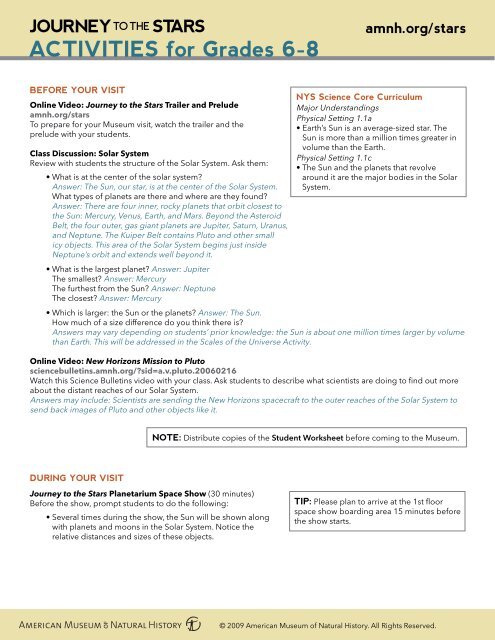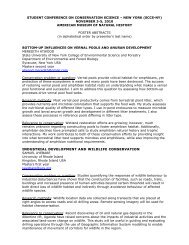ACTIVITIES for Grades 6-8 - American Museum of Natural History
ACTIVITIES for Grades 6-8 - American Museum of Natural History
ACTIVITIES for Grades 6-8 - American Museum of Natural History
You also want an ePaper? Increase the reach of your titles
YUMPU automatically turns print PDFs into web optimized ePapers that Google loves.
Investigate Sizes and Distances <strong>of</strong> Celestial Objectsamnh.org/starsSTUDENT WORKSHEET <strong>for</strong> <strong>Grades</strong> 6-8The circles on this page are scaled to accurately represent the relative size <strong>of</strong> objects in our SolarSystem. (Notice that one <strong>of</strong> circles is too large to fit on the page!) Observe the relative sizes <strong>of</strong> theplanet models and the Hayden Sphere, which represents the Sun.Label each circle with the name <strong>of</strong> the celestial object it represents (use the planet models and theHayden Sphere to guide you). Then look at the panels that list the actual sizes (diameters) <strong>of</strong> eachobject that you’ve labeled. Record the actual size <strong>of</strong> each object next to the name.Find the panel showing the Earthand the Sun. How many Earths couldfit in a hollowed-out Sun? _______________________Find the picture <strong>of</strong> theMoon on the panel tothe right <strong>of</strong> the planetpictures. Using thein<strong>for</strong>mation on thepanel, draw a circle<strong>of</strong> the appropriatesize next to the circlethat you have alreadylabeled as Earth.© 2009 <strong>American</strong> <strong>Museum</strong> <strong>of</strong> <strong>Natural</strong> <strong>History</strong>. All Rights Reserved.
STUDENT WORKSHEET <strong>for</strong> <strong>Grades</strong> 6-8Investigate Sizes and Distances <strong>of</strong> Celestial Objectsamnh.org/starsThe circles on this page are scaled to accurately represent the relative size <strong>of</strong> objects in our SolarSystem. (Notice that one <strong>of</strong> circles is too large to fit on the page!) Observe the relative sizes <strong>of</strong> theplanet models and the Hayden Sphere, which represents the Sun.Label each circle with the name <strong>of</strong> the celestial object it represents (use the planet models and theHayden Sphere to guide you). Then look at the panels that list the actual sizes (diameters) <strong>of</strong> eachobject that you’ve labeled. Record the actual size <strong>of</strong> each object next to the name.ANSWER KEYJUPITER140,000 kilometersSATURN120,000 kilometersSUN(HaydenSphere)Find the panel showing the Earthand the Sun. How many Earths couldfit in a hollowed-out Sun? ___________________________Answer: More than a million EarthsURANUS51,000kilometersNEPTUNE50,000kilometersEARTH13,000 kmVENUS12,000 kmMOON3,500 kmMARS6,800 kmMERCURY4,900 kmFind the picture <strong>of</strong>the Moon on thepanel to the right <strong>of</strong>the planet pictures.Using the in<strong>for</strong>mationon the panel, drawa circle <strong>of</strong> theappropriate size nextto the circle that youhave already labeledas Earth.© 2009 <strong>American</strong> <strong>Museum</strong> <strong>of</strong> <strong>Natural</strong> <strong>History</strong>. All Rights Reserved.
















